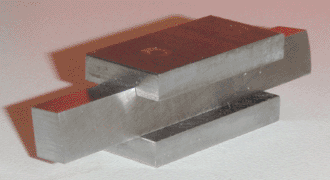
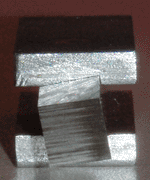
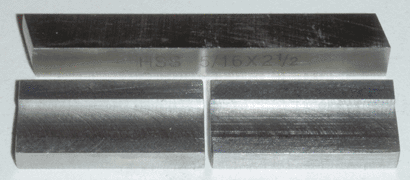
Having spent the past six months developing a number of coatings and lubricants, I will now return my focus to projects of a more mechanical nature, which will hopefully be able to utilize some of the materials I have produced. Before doing so, however, I have decided to make a number of minor upgrades to my metalworking tools and methods. The first of these improvements involves the shear tool, which in the past has been my go-to tool for producing extremely smooth surfaces on the lathe. This tool is simply a sharp vertical edge with a slight tilt, which acts as an inclined plane to peel away fine shavings of metal as the workpiece turns. Ordinarily this tilt is ground into the tool, which itself sits flat in the toolpost; however, this wastes a large amount of metal and often results in an imprecise tilt angle. Furthermore, it makes accurate resharpening tricky and time-consuming, which is unacceptable as this type of tool tends to dull quickly. Fortunately, this can all be resolved by making a tilted holder for an ordinary piece of tool steel.
To make such a holder I simply used my milling machine to cut a tilted notch (10 degrees from vertical) into two pieces of flat steel, which are sized so that the center of the cutting edge is at the center height of my lathe. The tool itself has no critical angles ground into it; it has a single relief angle of about 15 degrees on each end, and one end is rounded slightly so that it can shear flat surfaces (e.g. for facing cuts). This simplicity allows the tool to be removed, sharpened, and reinserted within a minute whenever necessary. The tool and holder can be seen at the top of the page, and the application and results can be seen below.
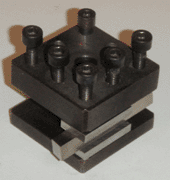
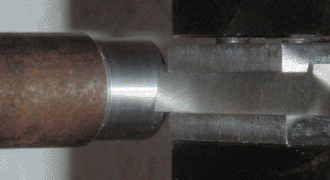
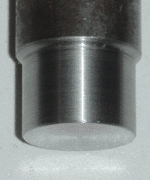
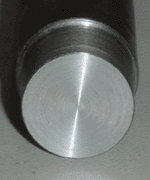
This tool is suitable for finishing any metal, and produces a glass-smooth surface even on tricky metals such as copper and mild steel (seen above). The maximum depth of cut is only a few thousandths of an inch, but there is essentially no minimum, and using this type of tool to shave a ten-thousandth from the diameter of a part is trivial. The only real limitations are that it requires a very slow feed rate, and that it cannot reach internal corners, although it does come close. This type of tool is indispensible in the home workshop, as it produces the equivalent of a ground finish without any specialized equipment, and without the inaccuracy inherent in hand-polishing. Hopefully this holder design will make shear tools more user-friendly, and help bring them into more common use.
This holder can be made more versatile by increasing the tilt angle to 20 degrees. This widens the cutting surface and allows for the use of power feed, since the tool has less of a tendency to dig in under pressure.